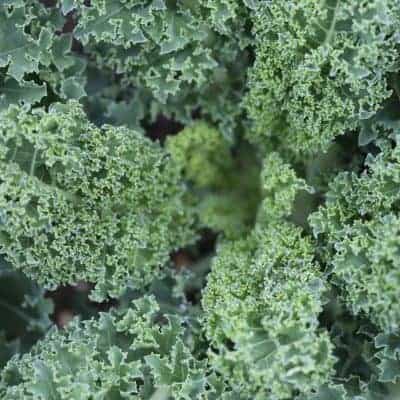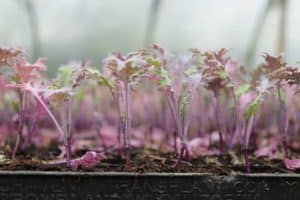If you’re a gardener and you live in an apartment or you’re stuck in the dead of winter, you’re probably feeling the itch to grow something right now. Or maybe you just want to dip your toes into gardening with some easy indoor projects. Either way, there’s been a growing trend (pun intended) to start gardening indoors for those without the extra space outside, and it’s never been easier to start growing kale indoors.

It’s definitely possible to grow kale indoors, but the keys to success are having enough space (container size) and enough light (natural and/or artificial). Depending on the variety of kale, it’s recommended to grow it in at least a 2-gallon (7.5 L) container at least 12 inches (30 cm) deep for a reasonable size. 5 gallons (19 L) is ideal to maximize plant size. is Another option is to grow it hydroponically, and even in a 1-gallon hydroponic reservoir you can get excellent results. As for lighting, kale grows best in 4-6 hours of full sun, so a grow light running for at least 10 hours a day (up to 18) is adequate.
On this page:
Advantages of Growing Kale Indoors
If you’re reading this article, you might already know some of the benefits of growing kale indoors. For one, you can keep growing kale 365 days a year no matter what the conditions are outside. Yes, kale is cold and frost hardy, even getting a sweeter taste after a light frost, but when it’s cold it grows slowly and it can die off if exposed to a really deep frost below 10°F (-12°C). Nowadays, with all the food safety scandals and health scares, having continual access to fresh, nutritious vegetables that you know exactly how they were grown has benefits you can’t really put into words.
If you’re a gardener, kale is a great choice to grow indoors because it’s relatively easy to grow. Not including microgreens, I would say maybe only lettuce is easier and faster to grow, but not much else can beat kale. Some salad greens grow very slowly or have high light or fertilizer requirements. Kale also doesn’t need much space, but some kale plants can get huge if you let them. But if you like cutting baby kale into salads or making kale chips, you can grow a ton in a small space indoors. By the way, if you live in an apartment and have a balcony, you can read my growing kale in a balcony article which goes into specifics.
Another benefit to growing indoors vis-a-vis outdoor gardening will depend on your location. Where I live, I NEED to either cover all my brassicas (kale, broccoli, cabbage, kohlrabi, etc.) with insect netting or check them almost daily in the summer because small white butterflies keep coming around to lay eggs on the leaves. They are a major pest and in the case of kale, they literally eat the same part of the plant you want to eat. Growing kale indoors removes all the pest pressure they normally face outdoors.
Disadvantages of Growing Kale Indoors
There are only a few disadvantages, and it all boils down to one thing: space. If you want to grow huge, monster kale, so you’re eating kale salads or juicing them almost daily, that kind of constant supply requires larger containers, more space, and also more lighting. As mentioned before, a minimum of a 2-gallon (7.5 L) container is what is recommended for decent-sized kale in pots, but if you want huge kale, you’ll have to plant it in a larger container or use hydroponics.
How to Grow Kale Indoors
Starting Indoor Kale from Seed
If you’re growing indoors in winter, you will probably be starting from seed. I always recommend this since it’s cheaper and you can get seeds of different varieties to try growing. Kale seeds are small, round balls, dark brown or black in color.
When sowing kale seeds, it’s usually recommended to start them in small seed trays. If you don’t have one, you can substitute it with an egg carton with holes cut in the bottom for drainage, and fill it with potting mix – don’t use regular garden soil from outside as you could bring in pests that could harm your seedlings. Plant 2-3 seeds per hole and thin out later. If you’re growing hydroponically, sow it into coco coir or a rockwool cube (or whatever hydroponic media of your choice).
Depending on your grow light, you should keep it 1-5 inches away from the top of the potting mix or hydroponic media to make sure there is adequate light for the seedlings when they emerge but without drying them out or overheating (cooking!) them.
When your seeds start sprouting, make sure you give them adequate water but don’t keep them soaked. They should remain moist as the seedlings are weak and the tiny roots are, well, tiny. Each sprout will have two seed leaves (called cotyledons), then they will develop their true leaves. At that point, you can feed the seedlings with a dilute liquid fertilizer, a quarter of the recommended strength. If you direct sowed them into their final pot, they should already have enough fertilizer in there to get them started.
The reason you plant 2-3 seeds per hole is to help guarantee you get at least one plant, since not every seed will germinate. But if all the seeds sprout, you need to thin them out by taking sharp scissors and cutting the ones you don’t want. You should select the strongest one. When kale seedlings have a few true leaves, you can transplant them into their final container.

Kale Light Requirements
Kale grows best in full sun, around 4-6 hours, but it also tolerates partial shade. However, if you are growing indoors, your grow light is not even remotely as powerful as the sun, so you should increase the time under lights (also called the photoperiod) to at least 10 hours a day, up to 18.
Why not leave the light on for 24 hours? More light means more growth, right? Yes, and it won’t kill your kale, but living under constant light conditions can negatively impact the development of some plants, so it is generally recommended to give them some periods of darkness.
What Grow Lights Should I Use for Kale?
If you don’t have enough access to direct sunlight, you will need a grow light. However, kale and most leafy greens do not need expensive lighting to grow. Although not very strong, you can use fluorescent lights such as T5 or T8 bulbs, or compact fluorescent lights (CFLs).
Kale’s sun requirements are more moderate compared to lettuce, but your indoor kale plants can certainly survive with fluorescents. You could also use a metal halide bulb, but these powerful lights are overkill for any kind of green leafy vegetables.
That leaves LED lights, with currently offer the best of both worlds – powerful lights at the right spectrum with low power usage and relatively low heat production. And gone are the days of strange “blurple” LED lights; most now produce natural full-spectrum lighting that is as pleasant for you as it is for your plants.
SANSI LED grow lights are recommended for people starting with indoor growing as they come in relatively small sizes but are extremely efficient. I successfully grew a (small) hydroponic watermelon using only two SANSI 36W LED lights, but that’s for another day.
Regardless of what light you choose, keep it as close to the plant without overheating it. Generally, the more powerful the light, the farther you can keep it without negatively impacting growth.
Ways to Grow Kale Indoors
Growing Kale in Pots
Growing medium: Use a light, fluffy potting mix that drains well. If using homemade potting mix, 1/3 compost, 1/3 peat or coco coir, and 1/3 vermiculite or perlite works well. I have seen success with mostly coco coir and vermiculite with added slow-release fertilizer. Avoid using all top soil or garden soil as it can be too heavy and lead to waterlogged roots.
Container size: The bigger the better, but at least 2 gallons (7.5 L) is recommended. You can technically grow in a smaller container, but overall plant size may suffer and you will need to water more frequently as the plant gets larger. Ensure that your containers all have adequate drainage holes to avoid root rot.
I typically grow mine outside in 3-gallon (11.4 L) containers or sometimes two plants in one 5-gallon container (19 L). If you want to maximize size, one plant in a 5-gallon container is more than enough. However, if you grow with hydroponics, you can get rather large plants in smaller containers.
Care: Growing kale indoors reduces a lot of the unpredictability of outdoor growing, so as long as you give it adequate water, fertilizer, and light, it will thrive. Water kale as you would other leafy plants, giving mature plants a good soak and then letting the top inch or so of the soil dry out before watering again. Seedlings will require more frequent but lighter watering.
As for fertilizer, your potting mix should have enough fertilizer for a few months of growth, but you can boost the growth of your indoor kale by feeding it with a high nitrogen fertilizer (larger first number in the NPK values) or just any all-purpose fertilizer.
Growing Kale Hydroponically
I could write several articles on hydroponics alone and there will be a forthcoming article dealing in more detail with hydroponic vegetables. For kale, any form of hydroponic growing (ebb and flow, deep water culture, non-circulating/Kratky, aeroponics, etc.) will work with it. My personal experience is with deep water culture (DWC) and the non-circulating/Kratky method.
In a nutshell, DWC keeps the plant roots submerged in a nutrient solution while an air pump (you can use a simple aquarium air pump) aerates the water so the roots have adequate oxygen. DWC requires the water level to be the same throughout the growing process.
In contrast, the Kratky method has no aeration and the roots are allowed to drink up the nutrient solution, which exposes some of the roots to the air and allows gas exchange so the roots (air roots) can still get oxygen.
The Kratky method, named after Prof. B.A. Kratky who developed and promoted this method, is simpler, but it can be tricky if you are growing something for several months in a relatively small container, as you will have to partially refill it several times in the season without drowning the air roots. The below video is a good demonstration of the Kratky method to get you started. It’s showing lettuce, but the concept is exactly the same for kale.
Regardless of what method you choose, a 1-gallon DWC or Kratky container is sufficient for beginners, and you can do successful Kratky test grows in even smaller containers. Nevertheless, with sufficient nutrients and lighting, a 3-gallon hydroponic bucket system is more than enough for a very large kale plant.
Hydroponic nutrient solutions should be selected for vegetative growth for the entire growth cycle.
Harvesting Kale Indoors
Harvest indoor-grown kale the same way you would harvest kale grown outdoors. Because kale keeps growing, use the “cut-and-come-again” method which is popular with kale and other leafy green vegetables like lettuce. Kale grows like a stalk, so carefully cut off the lower leaves as the plant is growing, leaving some leaves at the top so the plant can continue to photosynthesize and grow.
It’s recommended not to pull the leaves off by hand unless you can do it without damaging the main stem. Mature kale plants often look like a small tree with its bare bottom stem and vibrant growth up top. Try growing Tuscan/Lacinato/Dinosaur kale, which looks like a prehistoric palm tree!
